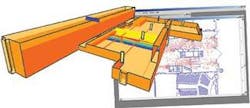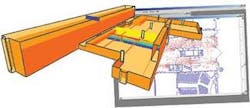FIRE SAFETY ENGINEERING: Fire protection analysis saves weight on offshore installations
State-of-the-art fire safety engineering from Fire Safety Design can provide significant cost savings on offshore installations. The company, which has been developing its services for almost 30 years, brings three main approaches to the business of providing optimized fire safety solutions, according to Tommy Wågsäter: performance-based design, risk analysis and health and environment impact assessment.
As an example of the contribution performance-based design can make to an offshore project, Wågsäter cites calculations of the behavior of load-bearing structures in different fire scenarios. Using FSD’s software, it is possible to calculate the optimized amount of fire protection material needed to achieve specified objectives. Compared with calculations using standard methods, this is likely to represent a significant reduction - in some cases up to two thirds - in the amount of fire protection material required.
For an offshore platform, in addition to savings in the cost of fire protection material, this would mean a reduction in the topsides weight and thus also in the substructure requirements, with consequent cost savings.
In the case of the fire safety design developed for pharmaceutical modules, FSD’s calculations indicated that the thickness of the fire protection material could be reduced by two thirds - from the 300 mm calculated by standard methods to 100 mm. That is not atypical, according to Wågsäter.
In-house software
FSD uses information from steel codes and manufacturers’ test data for the fire protection material as input into the computer modeling. The test data documents how the material behaves during a fire with respect to heat conductivity and capacitivity - the amount of heat it can absorb before it is destroyed. But the company can calculate these data if they are not available from the manufacturer, says Wågsäter.
“We develop our own computer programs,” says Wågsäter. FSD’s expertise includes the ability to calculate the degree of use of a load-bearing structure in normal and in fire states. Sometimes this exercise shows that a structure has more load-bearing capacity available in fire conditions than has otherwise been identified.
Again this knowledge has implications for the amount of fire protection material. For example, it is possible to calculate how much is required to ensure a specified time for evacuation before the structure collapses. Alternatively, it may be preferable that the structure should not collapse at all - if, for example, it is in an area containing process equipment. The amount of protection material required to achieve this aim can also be calculated.
While the design guide provided by steel manufacturers provides important information for fire safety engineering, not all eventualities are included. There are configurations which are not covered - for example, a steel beam attached to a steel column, in which case the two structures’ behavior in fire conditions is modified by the configuration. FSD has the software to calculate the optimized amount of fire protection material required for such a configuration.
Risk analysis
In recent years the company has broadened the scope of its activities to include risk analysis. The aim of this exercise is to calculate the risk of specific scenarios occurring and establish the consequences of the worst-case scenario.
“In the near future we will be able to combine our knowledge of the behavior of load-bearing structures in fire conditions with risk analysis in order to prevent the occurrence of the worst-case scenario,” says Wågsäter. “There will then be no need to protect the load-bearing structure against the worst-case scenario. This will be a new tool.”
A third area of FSD’s work is evaluating the impact of fire on health and the environment. For example, if people are injured, where can they be evacuated to? What damage is caused to the environment?
Risk considerations are important in an offshore context. An operator needs to know how vulnerable it is to different scenarios, and whether, in the event of a fire, rebuilding will take three months or six.
“We can calculate how long evacuation will take, how many emergency exits are needed, how long to allow before one can risk the collapse of a structure, how to collapse it, how many fire cells are needed, and so on. We are able to arrive at solutions which cost less and are more flexible.”
However, a constructive dialogue with the client is first needed to clarify precisely what they want and what FSD can deliver. “Talking risk is a main area for us,” says Wågsäter. “We always ask our customers what will be the consequences of this or that scenario, and maybe identify the scenarios which need to be avoided, or the consequences of which need to be minimized.”
“This is a new approach for many of our customers - they want immediate answers. But we ask them questions about the consequences - we are introducing them to risk thinking. This approach leads to more optimized solutions than the traditional approach, which in some ways tries to cover all scenarios but does not come up with an optimized solution for them all.”
For more information contact Tommy Wågsäter, Fire Safety Design. Tel +46 40 680 0770, fax +46 40 680 0779,[email protected], www.fsd.se

